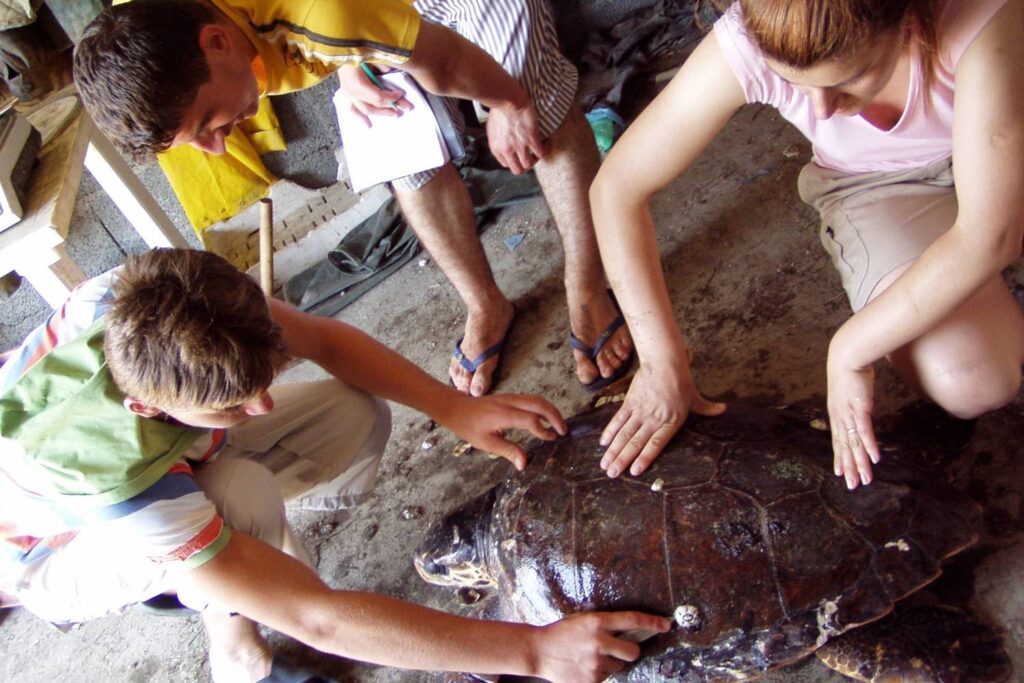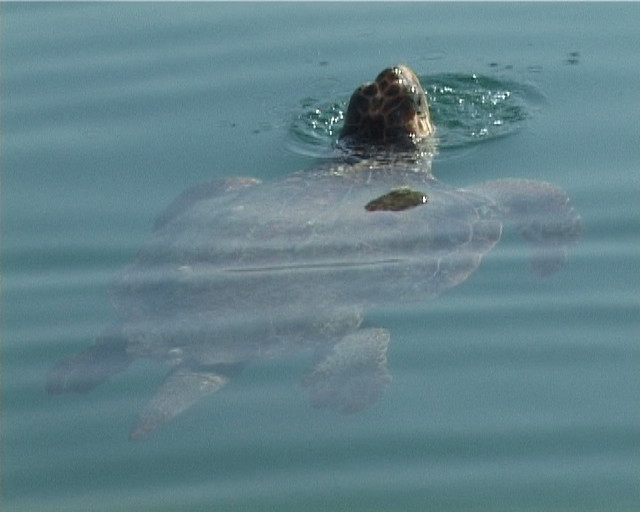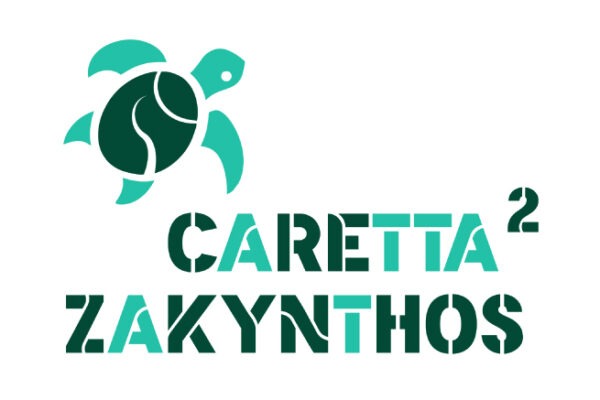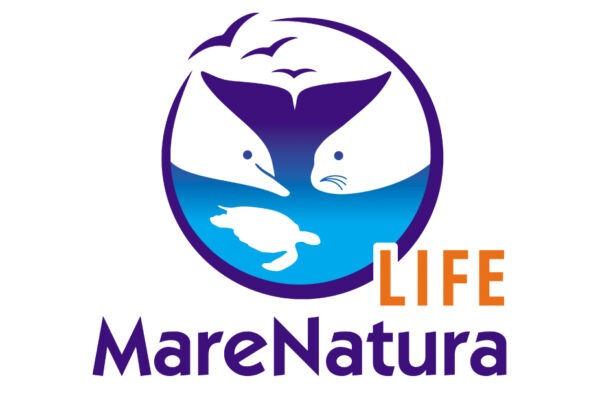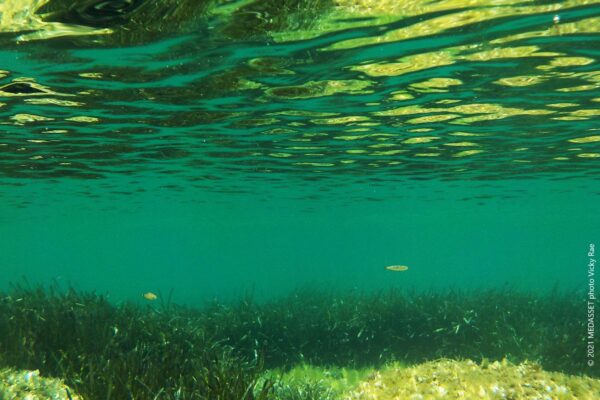Important Sea Turtle Feeding Grounds in Patok, Albania
Following our 2005 Rapid Assessment of the Albanian coast for sea turtles and monk seals, in 2008 we launched the three-year scientific project “Monitoring and Conservation of Important Sea Turtle Feeding Grounds in the Patok Area of Albania.” Project partners included the University of Tirana, Albania; University of Adnan Menderes Department of Biology, Turkey; the Herpetofauna Albanian Society; and ECAT–Tirana. The aim was to assess if sea turtles used the area to feed and to systematically investigate the population structure. At the same time, the project strengthened local capacity to monitor the species and raised awareness locally and nationally about the plight of the sea turtles.
The research team was based at the Patok Lagoon area (also known as Patoku or Patogu), which belongs to the Patok-Fushe-Kuqe Managed Nature Reserve and is located within Drini Bay on the northern coast of Albania. Drini Bay expands from Cape Rodoni to the northern border of the country.
Each summer (June-September) researchers studied sea turtles with the help of the local fishermen who caught them incidentally in “stavnike” fish traps – a particular type of static fish trap used in the Patok area. All local fishing gear and target fish species were also documented. A remarkable 407 sea turtles were studied, tagged and released. Tagging turtles’ flippers helps researchers to identify them if seen again in the future. This systematic monitoring and tagging revealed some turtles remain in the bay during the summer (short-term residency), while interannual capture of some turtles suggested that Albania forms part of their migratory route. A few tagged turtles were also reported nesting in Greece or seen at sea in Tunisia.
DNA samples were collected from some turtles for analysis, and findings suggested that the source population of loggerhead turtles foraging in Drini Bay is most likely from Greece. Two previously unknown haplotypes were also described by the study. In order to further investigate the migration and marine distribution of turtles found in Albanian waters, three loggerhead turtles (two males and one female) were fitted with transmitters in 2009, and the first satellite tracking programme of sea turtles in Albania was launched from Patok lagoon. This long-term programme further corroborated research conclusions.
The project concluded that Drini Bay is a regionally and nationally important habitat that is used by sea turtles for foraging, as a refuge and as part of a key migratory corridor between the Ionian and Adriatic seas. Drini Bay is used:
- by both adult and adolescent loggerhead turtles (Caretta caretta)
- occasionally by green turtles (Chelonia mydas) for foraging or migration
- by juvenile loggerheads and perhaps green sea turtles as a developmental habitat
- by loggerheads as an overwintering habitat
- by a significant assemblage of male loggerhead turtles suggesting that they may use the area as a developmental and foraging habitat. This discovery has increased importance due to our presently limited understanding of the distribution and marine ecology of male sea turtles, and the threatened impact of global climate change, which may force embryonic sex ratios towards female dominance.
Another important finding was that “stavnike” have proved to usually be non-lethal for turtles. It was noted that hooked turtles were very rare, as were turtles with amputated limbs. The principal concerns identified for turtles in Drini Bay include: incidental injury caused by interaction with fisheries and boat strikes; the presence of marine leeches and high loadings of epibiota, and the unknown effects of anthropogenic pollution.
A waste pollution survey was conducted in the coastal zone of Drini Bay and upstream in five rivers during 2009-2010: the widespread presence of marine litter in Drini Bay, in conjunction with the omnivorous nature of loggerheads, makes it likely that they will consume plastic and other debris. The illegal use of dynamite for explosive fishing was monitored during 2008-2010 and reported to the authorities; this was the first recorded evidence of such activity and consequently an enforcement operation was undertaken in September 2010.
The project was funded by MEDASSET, the Global Environment Facility’s Small Grant Programme (GEF/SGP), the Regional Activity Centre for Specially Protected Areas (RAC/SPA), the United Nations Environment Programme Mediterranean Action Plan (UNEP/MAP), the British Chelonia Group (BCG), the J.F. Costopoulos Foundation (Greece), the Spear Charitable Trust (UK) and the Panton Trust (UK).
Future Needs
The population in Drini Bay has yet to be completely understood. A bycatch assessment including trawls, nets, longlines, and small-scale and artisanal fisheries is necessary in order to thoroughly study the degree of interaction between sea turtles and fisheries in Albanian waters. Effects of waste and pollution need to be investigated and mitigated. Further training of local scientists and education of fishermen will also be beneficial to sea turtle conservation in Albania.
Learn More. Check out our publications section for the project report, articles and papers stemming from this project.
Read SWOT’s report on our project.
Our project is also presented at GEF’s website here.
MEDASSET is dedicated to enhancing local knowledge and empowering local communities, authorities, researchers and NGOs in studying and protecting sea turtles and marine life in general.In Albania, during our 2005 Rapid Assessment Survey, scientific expertise was transferred to local scientists and university students through demonstration and training activities on research methods, both theoretical and onboard the research boat. Communities and fishermen were educated about the endangered status of sea turtles, monk seals, and the general need for stewardship and protection of marine life.
We continued building local capacity during 2008-’10 through our project “Monitoring and Conservation of Important Sea Turtle Feeding Grounds in the Patok Area of Albania” We sought to build capacity within our local partner NGO, the Herpetofauna Albanian Society, sharing fundraising and project management know-how. The project trained 11 Albanian university students as research assistants, providing young biologists with hands-on training and instilling the capacity to the next generation of Albanian scientists to monitor the sea turtle population along their coast. Over 250 Albanian university students also had the opportunity to attend short workshops at Patok through this project. Research on sea turtles was brought closer to internationally acceptable standards, while several of the trained students moved into careers related to sea turtle conservation or environmental conservation in general. Throughout the project, the local community, fishermen and tourists were informed about the sea turtles’ plight, and awareness was also raised through local and national media. The project researchers worked with the fishermen and continually demonstrated good animal-handling skills, while advocating best conservation practices and care towards the animals. The project’s results were disseminated internationally via several channels putting Albania “on the map” as an important range state for sea turtles in the Mediterranean.
The second year of the project “Monitoring and Conservation of Important Sea Turtle Feeding Grounds in the Patok Area of Albania 2008-10” included the first-ever sea turtle satellite tracking study launched from Albania. In addition to traditional research methods (measuring and flipper tagging), the study aimed to shed further light on the migration patterns of sea turtles found in this region.
Three turtles (one female and two males) which were caught incidentally by local fishermen in their special “stavnike” fish traps were fitted with transmitters and then released back into the sea on Sept. 12, 2009. Local fishermen, Albanian biologists and students from Tirana University, members of the local community, and tourists watched the release. Media coverage was extensive.
Guximtari
Species: Caretta caretta
Male, sub-adult
Flipper tag: left anterior AL0153
Curved Carapace Length = 69.5 cm
Curved Carapace Width = 65 cm
Other characteristics: split Nuchal scute (very rare)
Guximtari was first captured on Aug. 29, 2009, in a stavnike in Patok. He has an interesting feature on his carapace: the foremost “nuchal” scute is split into two; this is very rare (Dr White has only seen this in eight turtles from over 400 recently examined). Guximtari (green route) initially showed fidelity to the neritic environment near Patok where he may have been feeding and later may have been in a state of dormancy in response to environmental conditions. From February till June 2010 he was moving within Croatian waters. Just like Patoku, in July 2010, he returned to Drini Bay, providing direct evidence for the timing of the return, and remained there till December 2010. Then he travelled southwards through the southern Adriatic Sea and into the northern Ionian Sea where he remained until May 2011. In mid-May he headed north, up the Albanian coast, and on June 16 his transmission showed he returned to Drini Bay and Patoku Lagoon for the third consecutive summer and remained there until October 2011. His last transmission showed he had commenced his journey away from Drini Bay, heading down the Albanian coast, 119 kilometers away from where he was released in September 2009. He swam 6,052 kilometers*!
Shpresa
Species: Caretta caretta
Female, possibly early adult
Flipper tag: left anterior AL0154
Curved Carapace Length = 76 cm
Curved Carapace Width= 67 cm
Other characteristics: Lower beak is cleft
Shpresa was first captured on May 26, 2007, in a stavnike in Patoku and was recaptured on Aug. 13, 2009, once again in the stavnike. During the 27-month interval between the recaptures, the turtle’s carapace grew remarkably. The tail measurement taken in 2009 indicated this turtles was a female, perhaps approaching maturity. At the time of her second capture, she was covered in leeches (blood-sucking parasites). Dr. Michael White kept her in freshwater for three days so that the leeches would die and fall off. She was then released on Aug. 16. Two weeks later she was captured again in the stavnike, which means that she likely stayed in the Patoku area feeding on benthic animals, such as crabs and bivalves. This made her quite special for our researchers because it seems she returns to Patoku in different years, or perhaps she lives nearby for much of the time. Tracking showed (route in pink) that she remained within close range of the release site. Over half of her transmissions were at sea depths of -10 to -25 meters but she also swam in waters as shallow as 0 to -10 meters and as deep as -100 to -500 meters! Her device transmitted successfully until April 2011, and based on these transmissions, it is calculated that she travelled a distance of 229 kilometers*. The lack of transmissions from her device may have been due to the local topography or a device malfunction. She was sighted by local fishermen again during summer 2010.
Patoku
Species: Caretta caretta
Male, sub-adult
Flipper tag: right anterior AL0150
Curved Carapace Length = 66 cm
Curved Carapace Width = 65 cm
Other characteristics: extra vertebral scute and split right costal scute
Patoku was first captured on July 1, 2008, and recaptured in September 2009 in a stavnike in Patok. He was chosen as very little is known about the distribution and marine ecology of male turtles. Researchers have located mating areas of adult males in different parts of the world; however, we know almost nothing about adolescent males. Guximtari and Patoku provided us with some useful information about this life stage. Patoku (yellow route) was an international traveller from the beginning, notching up to five territories: Albania, Croatia (five days), Montenegro (five days), and one day in international waters. He remained north of Corfu Island in Greek waters between November 2009 and March 2010. He probably used an underwater ridge to the north of Corfu, which is likely to have extensive limestone caves and abundant foraging resources. Since then, his device went silent until May 6, 2010, when a transmission was received locating him back at Drini Bay! This was the first direct evidence for the timing of a remigration into the bay. He remained in the bay until his last transmission in November 2010, which placed him just 39 kilometers away from the release site. He covered a total distance of 1,254 kilometers*.
How does it work?
Every time the turtle surfaced for air, the transmitter attached to its shell sent a signal with the turtle’s location to satellites around Earth, which was in turn sent directly to researchers’ computers.
What do the turtle names mean?
The turtles were given Albanian names to celebrate this important milestone in the country’s wildlife conservation history: “Guximtari” in Albanian means “brave and courageous,” “Shpresa” stands for “hope for living,” and “Patoku” was named after the location to pay tribute to the community that hosted the research project.
Why satellite tracking?
For most sea turtle populations, knowledge of the biology beyond the nesting beach remains deficient, and knowledge on the migration of male turtles is especially scarce. Satellite tracking studies of marine turtles have begun to highlight migratory corridors (e.g. Morreale et al. 1996) and important foraging sites (e.g. James et al. 2005). Typically marine turtles migrate hundreds or thousands of kilometres between specific breeding and foraging grounds (Plotkin 2003). We do not know where the turtles found in Patok come from, if they remain in the area for a period of time, or where they head to after Patok. With a satellite tracking program in place, it was possible to better understand sea turtles’ foraging ecology, study migration routes in the Adriatic Sea (into the Ionian Sea and elsewhere in the Mediterranean), and locate possible overwintering habitats and mating sites.
- Country Albania
- Approach Research
- Theme Sea Turtles & Habitats



